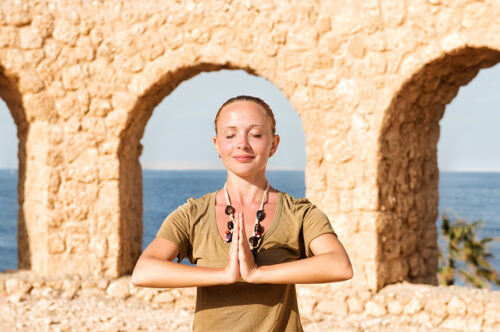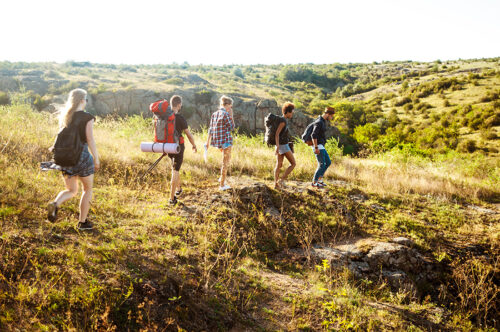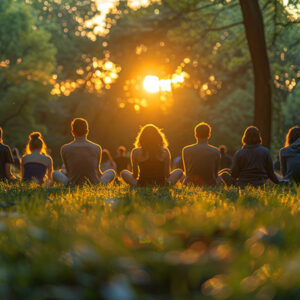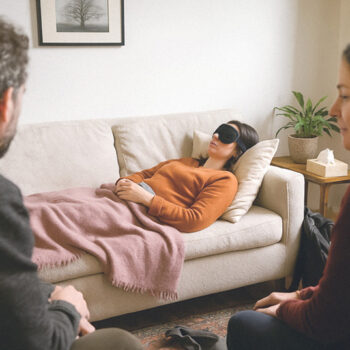5 Wellness Retreats to Reclaim Your Inner Peace

In the face of burnout, fragile mental health and recurring depressive episodes, sometimes a pause is essential. Taking a step back, carving out time for oneself. But going on a spiritual retreat isn’t always straightforward. You need to choose the right format, the right length… and, most importantly, understand the pros and cons of the different options available. Here’s a short guide to help you find the wellness retreat best suited to your needs.
Yoga & Meditation Retreat

Slowing down with awareness
The idea behind a yoga or meditation retreat is simple. It’s about reconnecting body and mind through gentle, regular practices guided by the breath. In this kind of wellnes retreat, yoga sessions shape the rhythm of the day. Meditation forms its inner foundation. The natural setting – usually chosen for its beauty and tranquillity – helps support this recentring. You learn to pause, to gain perspective.
Who is it for?
This format suits those overwhelmed by mental hyperactivity, diffuse anxiety, or a sense of exhaustion. It also works well for people who’ve never embarked on an inner journey but feel the time has come to breathe.
✔️ Its main strength lies in its gentleness. You’re welcomed exactly as you are, without judgement, and encouraged to go at your own pace. It’s an effective decompression chamber.
❌ That kindness has its limits: it tends to stay on the surface. Deeper issues are rarely explored. For people facing existential crises, this may feel insufficient. You learn to slow down – not necessarily to transform.
A typical yoga retreat includes:
- Two to three yoga sessions daily (hatha, vinyasa or yin)
- Guided or silent meditations
- Breathwork (pranayama)
- Sometimes sharing circles or intuitive writing
- Some formats also include mindful walks, yoga nidra, Qi Gong, or workshops on conscious eating.
Length ranges from a weekend (for a short reset) to 7 days for a more in-depth experience.
Silent Monastery Retreat
Silence as hospitality
The concept is ancient and largely unchanged: spending a few days in a monastery or abbey, in silence. Participants partially follow the rhythm of monastic life: rising at dawn, attending sung offices in the church or chapel, eating in silence, sometimes taking part in manual or community tasks.
There’s no imposed method. The silent retreat offers a bare presence – a space for inner resonance. Silence isn’t enforced rigidly but encouraged as a way of being, breathing, and listening.
When is it helpful?
The silent retreat is more than a wellness retreat. It’s for those seeking inner peace. It’s not necessarily about radical transformation. People often come after a loss, burnout, or life transition. The need to withdraw from the noise takes precedence.
Despite assumptions, this is not a religious retreat. You don’t need to be a believer. Even in Catholic or Buddhist monasteries, many guests come with no religious affiliation. You simply need to respect the space and its rules. This setting can suit people who are mentally drained – but it offers no therapeutic support. There is no therapy or psychology here. It is the container itself that heals.
✔️ Silence has a rare power: it envelops. It doesn’t cut you off from the world – it holds it differently. It provides a form of rest that more active retreats do not. The attention to rhythm, light, and simple gestures – eating, walking, listening to psalms – gives time a new depth. A retreat low in stimulation but rich in presence.
❌ But that simplicity can be destabilising. Some feel overwhelmed by a silence they hadn’t expected to be so vast. There are often no group discussions, no expression workshops, no personal guidance. If you’re going through a deep psychological crisis or inner confusion, it may be too much. This is not a space for emotional analysis or interpretation.
Typical day and duration
There are no spiritual exercises in the conventional sense. Days revolve around the offices (lauds, terce, vespers, compline…). Participation is voluntary, and you may be invited to sing with the community. The rest of the time is left for reading, prayer, silent walking, or personal writing. Some monasteries offer one-to-one spiritual accompaniment.
Stays usually last 2 to 5 days. Some abbeys welcome guests for a full week.
Psychedelic Retreat

Letting the unconscious speak
In a transformational psychedelic retreat, the core of the process involves the guided use of psychoactive substances – most commonly psilocybin or ayahuasca. Far from recreational, it’s a deep inner journey. Preparation and follow-up coaching are often included. Ceremonies are ritualised and inward-looking, often rooted in shamanic traditions.
This type of retreat is for those ready to take a genuine inner leap. It’s often described as a breath-taking experience. Many come after a long period of suffering: resistant depression, trauma, grief, loss of meaning. It is not a comfort zone – it’s a point of rupture.
✔️ The potential benefits are immense: rapid access to unconscious knots, thawed emotions, a sense of inner reintegration, dissolution of isolation. Numerous clinical trials confirm the effectiveness of hallucinogenic mushrooms in cases of major depression or PTSD.
❌ A psychedelic journey requires a legal and high-quality setting. These retreats are only legal in a handful of countries (such as the Netherlands or Costa Rica). Moreover, integration is crucial. Without proper follow-up, the visions and emotions triggered can become overwhelming. Ensuring the right legal and human conditions requires serious commitment.
What does the programme involve?
Everything revolves around the ceremonies (one or two per retreat), with preparatory mental workshops including:
- Somatic grounding (breathwork, shaking) ;
- Post-experience integration (sharing circles, support) ;
- Some retreats also include sound healing sessions.
Duration usually ranges from 3 to 5 days, depending on the depth of work.
Fasting Retreat
Emptying to rediscover oneself
Fasting isn’t just a dietary act – it’s a rite of passage. For several days, the body stops digesting and begins to repair. Combined with walking in nature, rest, and gentle treatments (massages, sauna), fasting becomes a form of total purification.
It speaks to those who feel saturated – physically and mentally. It attracts a wide range of people wanting to reset. Often after excess, chronic fatigue or low-level addictions.
✔️ Many report impressive mental clarity, a surge in energy, and heightened awareness of the links between food, emotions and life rhythms. The body, calm and inspired, becomes an ally rather than a machine to push through.
❌ Fasting is not trivial. The first few days can be tough – fatigue, headaches, irritability. It may also trigger control behaviours or old patterns in people with complex relationships to food. Strong medical or naturopathic supervision is essential.
What to expect
Days are structured around:
- A morning walk (5 to 10 km) ;
- Educational workshops (nutrition, digestion, refeeding) ;
- Body treatments (massage, sauna, drainage) ;
- Yoga or relaxation sessions.
Standard duration is 6 to 8 days, with a progressive refeeding phase at the end.
Sport Wellness Retreat

The body as release
In these sport-oriented retreats, the body takes the lead. You run, climb, paddle, sweat. The goal isn’t performance – it’s about self-transcendence through movement. The settings are often spectacular – ocean, mountain, wilderness. You feel alive because you’re in motion.
These experiences are ideal for people stuck in overthinking or rumination. For those who somatise their distress: tension, insomnia, nervous fatigue. It’s a powerful decompression method.
✔️ The benefit is often immediate: a rush of endorphins, a sense of achievement, renewed confidence. Movement helps reconnect with a vital force that had gone dormant.
❌ But that intensity can become an escape if not balanced with introspection or listening. You can sweat out your anger… and never understand it. For those with severe burnout, physical effort may be too much.
A fast-paced rhythm
Days alternate between main sport activities (trail running, surfing, hiking, climbing…) and complementary sessions. These often include:
- Physical preparation, stretching, yoga ;
- Active breathing (Wim Hof, cardiac coherence) ;
- Cold water immersion or guided meditation ;
- Occasionally, group sharing or feedback circles.
Retreats usually last between 5 and 10 days. Some longer formats offer full immersion.
Enjoy a 100% legal psilocybin experience in the Netherlands
Preparation and retreat in English
Enjoy a legal & intense experience in the Netherlands
A psychedelic retreat designed for best results. Small group, one-to-one preparation, experimented facilitators, 1 year monthly integration & awesome place !
Join us

Image from nikitabuida to cookie_studio on Freepik
Last updated on 28 March 2025





